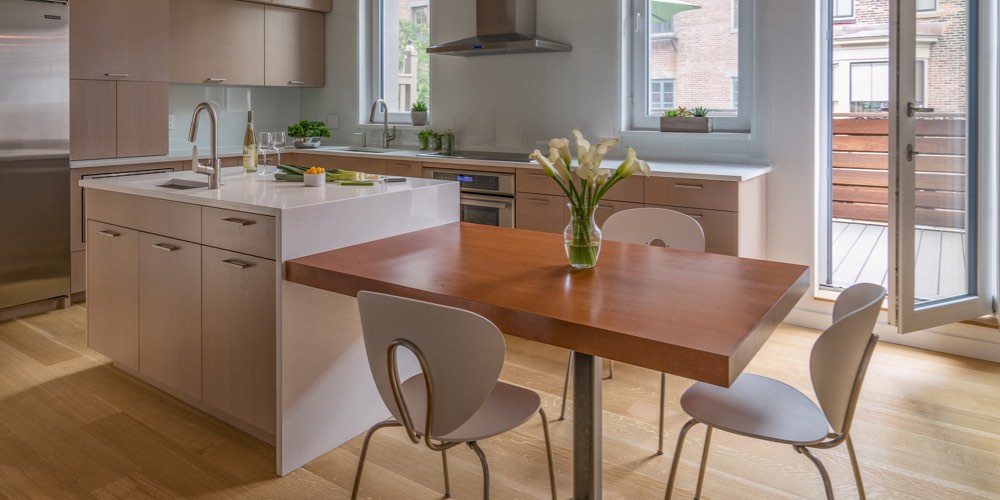Is Hardwood Flooring Worth It For My Home?

Wood has been the go-to flooring material for centuries, and for good reason. Its natural beauty and relative durability makes it an easy choice. Unlike many alternative materials that are found in fairly specific locations, trees are widespread, growing in most parts of the planet, so wood has been, and continues to be an accessible and cost effective means to create a pleasant surface beneath our feet. Wood offers other benefits. In a time of growing ecological concern, trees are a renewable resource, replenishing themselves, especially if managed and harvested with care. When they wear, most wood products have the unique capacity for renewal, with a sanding away of the accumulated imperfections,
and thereby extending its usable life.
Proliferating Options
So, as with any good thing, people have found new ways to work with wood – creating new products that accentuate its strengths, or making effective use of wood species or related products and by-products previously thought to be ineffective or unusable.
As such, a trip to the flooring store today presents the consumer with a variety of options. Wood flooring is not a simple choice between species any more. Laminates, engineered lumber, tropical and exotic species, cork, bamboo, and domestic solid hardwood all have found their niche, each offering pros and cons. Let’s explore these proliferating options through the lens of beauty, durability, and sustainability.
Sustainability
As expressed above, all wood flooring products emanate from a renewable resource, which is a plus when compared to non-wood-based options. But their green qualities diverge when taking into consideration other factors, such as the energy utilized in their production process and shipping, the health effects of the materials and chemicals utilized in their manufacture, as well as their lifespan.
Solid hardwoods are a minimally processed, virtually pure product. If the trees are managed and harvested sustainably (FSC-certification is a must), and the planks are milled and installed at a relatively close geographic distance, it is hard to beat hardwood as a green choice. Engineered lumber’s thin veneers of hardwoods or softwoods stacked and glued to one another is also an eco-friendly option, with many of the same qualities of solid hardwoods. Critical is to locate engineered flooring producers that utilize only formaldehyde-free glues in the manufacturing process, minimizing unhealthy off-gassing of Volatile Organic Compounds (VOCs).
Laminate flooring is made by compressing layers of fiberboard together and placing a photographic image on top covered by a protective coating. Laminates are considered by many to be eco-friendly due to the fact that the fiberboard is most often created either from wood waste products that would otherwise wind up in the landfill, or from recycled materials. And the boards themselves can then be recycled at the end of their lives. But the production process is extremely energy intensive, and many brands are made in Europe, requiring trans-Atlantic shipping. Some laminates may contain
formaldehyde, and may require adhesives during installation, though many brands now use an adhesive-free click-lock system that avoids glues.
Bamboo and cork both tout themselves as the ultimate green flooring options, which is true in some regards, but not in others. Cork is made from stripping the bark from a living cork oak tree, which then replenishes itself within 8–10 years. Bamboo, a fast growing, woody tropical grass takes renewability to an even higher level, maturing in just 3–5 years. Both are hypo-allergenic and bio-degradable.
Cork is manufactured in a relatively benign way, utilizing resins to bond the compressed material together, while bamboo is laminated together using pressure, heat, and in some instances, a urea-formaldehyde adhesive that can release VOC’s into your living space over time. Both manufacturing processes are energy intensive, as is the transport of the products from their native habitats – bamboo from Asia, and cork from Mediterranean Europe and North Africa.
Durability
Beauty is in the eye of the beholder, as the saying goes. As such, it is challenging to rank wood flooring on a scale of attractiveness or aesthetic quality. Add to that the fact that the milieu in which that flooring will reside will present variables that may speak to one “look” over another. The architectural style of the home, the colors of the walls, the type of furnishings, the surrounding landscape – all of these will push and pull on the aesthetic qualities of the space, affecting what type of flooring fits well.
That said, there are some commonly held assumptions that we can lean on, the first being that the natural grain patterns and coloring of domestic hardwood species provides a warmth and comfort that is hard to beat. And within that pantheon of species, some rise to the top for their exquisite tones and markings, notably cherry, with its elegant, lustrous hues, satiny texture, and gentle, swirling heartwood character; walnut’s luminous, coffee bean-brown color with purplish overtones and golden sapwood patterns; and red oak’s creamy reddish pinks superimposed with occasional white to light brown sapwood and coarsely patterned grain characteristics. Other domestic species offer their own appeals as well, and in general, it is fair to say that solid domestic hardwood planks hold a profound aesthetic appeal.
Engineered hardwood, which utilizes a thin layer of solid hardwood on its surface, provides identical visual delights as solid hardwood, so the choice between hardwood and engineered should be based on other qualities.
The aesthetic merits of laminates are a different story. Their visual component depends on the quality of the photographic image affixed to the compressed layers of fiberboard below. Different manufacturers have achieved differing levels of proficiency in this regard, so the quality varies. What can be said, though, is that laminates offer a wider range of options than hardwood and engineered products, as the photographic image utilized can mimic just about anything, including stone (Tuscan Stone and Vanilla Travertine, for example), antique, vintage, reclaimed or hand-scraped effects, or exotic and tropical species, and can suggest varying plank widths.
Bamboo’s iconic look comes from a combination of its naturally light color, its culm (the fine-grained stalk), and its distinctive nodes (often called knuckles). These defining aesthetic features can be cut to showcase those aspects in either a horizontal or vertical fashion. Carbonization or other surface treatments can darken the bamboo, or help it adopt the look of walnut, oak, or pine flooring. In general, bamboo’s look provides a uniform, clean, contemporary vibe.
Cork flooring has its own unique aesthetic vibe. The least expensive cork flooring comes in sheets, and looks like compressed granules of light brown color (just like the cork in wine bottles), so the result is an informal, somewhat retro aesthetic which will either attract you or not. However, premium cork floors have a top decorative layer of cork which can be finished in a wide range of colors and looks. This veneer can be stained, etched, bleached, painted and installed in different patterns. They can even be finished to look like bamboo, marble or hardwoods
Conclusions
Whether aesthetics, durability, or sustainability drive your decision-making, wood-based products generally rank high in all three regards, so you can rest easy that whichever product you select in the end, you will have many years of pleasure and beauty underfoot.







